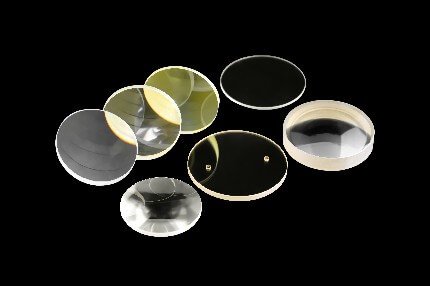Zinc Sulfide (ZnS) Lenses: Properties, Applications, Manufacturing, and Advancements

Zinc Sulfide (ZnS) lenses are critical optical components known for their excellent performance in the infrared (IR) spectrum. This article explores the fundamental aspects of ZnS lenses, including their properties, diverse applications, manufacturing techniques, recent advancements, and future prospects in optical technology.
Introduction to Zinc Sulfide (ZnS) Lenses
Zinc Sulfide (ZnS) is a robust material widely used in optical applications due to its exceptional optical properties and mechanical durability. ZnS lenses are precision optical elements designed to focus and manipulate IR radiation with high efficiency and minimal absorption, making them indispensable in various scientific, industrial, and military applications.
Properties of Zinc Sulfide (ZnS) Lenses
ZnS lenses exhibit several key properties that make them highly suitable for IR optical applications:
- High IR Transmission: ZnS lenses offer excellent transmission in the infrared spectrum, typically from approximately 0.4 microns (µm) to 12 microns (µm). This broad transparency range allows ZnS lenses to transmit IR radiation with minimal absorption, making them ideal for IR imaging, thermal sensing, and laser systems.
- Low Absorption Coefficient: ZnS has a low absorption coefficient in the IR spectrum, ensuring efficient transmission of IR light with minimal loss of intensity. This property is crucial for maintaining optical clarity and fidelity in IR-sensitive applications, including thermal imaging and remote sensing.
- Mechanical and Thermal Stability: ZnS lenses are mechanically robust and thermally stable, capable of withstanding temperature variations and mechanical stress. This durability ensures reliable performance in harsh environments such as aerospace, defense, and industrial applications.
- Optical Precision: ZnS lenses are manufactured with high precision to achieve low surface roughness, minimal wavefront distortion, and precise optical power. These characteristics contribute to superior imaging performance and spectral accuracy in IR imaging and spectroscopic instruments.
Applications of Zinc Sulfide (ZnS) Lenses
ZnS lenses play a crucial role in various scientific, industrial, and military applications:
Infrared Imaging and Sensing
ZnS lenses are integral components in IR cameras and sensors for capturing thermal radiation emitted by objects. They enable clear and accurate IR imaging in applications such as surveillance, industrial monitoring, and medical diagnostics.
Laser Systems
In laser systems, ZnS lenses serve as focusing optics for CO2 lasers operating at wavelengths around 10.6 microns. Their high IR transmission efficiency supports applications in laser cutting, welding, and medical laser treatments.
Aerospace and Defense
ZnS lenses are used in aerospace and defense for IR optics, missile guidance systems, and optical lenses. Their robustness and optical performance enhance situational awareness, targeting accuracy, and reconnaissance capabilities in military and aerospace applications.
Scientific Research
ZnS lenses facilitate IR spectroscopy and analysis in scientific research, enabling detailed study of molecular structures, chemical compositions, and material properties with high sensitivity and precision.
Manufacturing of Zinc Sulfide (ZnS) Lenses
The manufacturing process of ZnS lenses involves specialized techniques to ensure high optical quality and performance:
- Material Synthesis: ZnS is synthesized through chemical vapor deposition (CVD) or hot pressing methods to produce optical-grade material with uniform properties and high purity.
- Precision Machining: Optical components are machined from ZnS blanks using diamond turning or grinding techniques to achieve precise dimensions, curvature, and surface quality according to stringent optical specifications.
- Coating and Surface Treatment: Anti-reflection coatings tailored for IR wavelengths are applied to ZnS lenses to enhance transmission, reduce surface reflections, and improve durability. These coatings optimize optical performance in diverse IR-sensitive applications.
Technological Advancements in Zinc Sulfide (ZnS) Lenses
Recent advancements in ZnS lenses focus on enhancing their optical performance, durability, and integration capabilities:
Advanced Optical Coatings
Innovations in coating technologies improve the spectral performance, durability, and anti-reflective properties of ZnS lenses. Advanced coatings enable ZnS lenses to withstand higher laser powers, reduce surface scatter, and maintain optical integrity in demanding applications.
Multispectral Imaging Capabilities
Research efforts aim to expand ZnS lenses’ spectral capabilities to encompass broader ranges, including UV, visible, and extended IR wavelengths. This expansion enhances their utility in multispectral imaging systems and advanced optical technologies.
Integration with Emerging Technologies
ZnS lenses are increasingly integrated with emerging technologies such as quantum optics, photonics, and optoelectronics. These integrations enable compact, high-performance optical systems for telecommunications, sensing, and advanced imaging applications.
Future Directions for Zinc Sulfide (ZnS) Lenses
The future of zns refractive index is driven by ongoing research and development initiatives focusing on:
- Advanced Manufacturing Techniques: Innovations in crystal growth, precision machining, and nanostructuring to enhance optical performance, reduce manufacturing costs, and enable scalability.
- Expanded Applications: Exploration of new applications in fields such as biophotonics, environmental monitoring, and renewable energy technologies, leveraging ZnS lenses’ unique optical properties and durability.
- Technological Integration: Integration of ZnS lenses with advanced sensor technologies, wearable devices, and quantum-enabled systems for enhanced functionality and performance in diverse applications.
Conclusion
Zinc Sulfide (ZnS) lenses represent a critical component of modern IR optics, offering high transparency, mechanical robustness, and optical precision across the infrared spectrum. As advancements in materials science, manufacturing techniques, and optical engineering continue to evolve, ZnS lenses will play a pivotal role in advancing IR imaging, laser systems, scientific research, and defense applications. Leveraging the unique properties of ZnS, researchers, engineers, and innovators can drive innovation, develop new technologies, and address complex challenges in optics and photonics.







